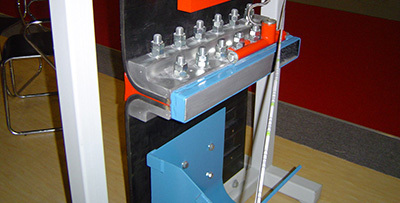News Center
Hezi technology focuses on the research and development of "rapid seamless conveyor belt joint sleeve" innovative technology project

NEWS CENTER

News Details
Understanding the Testing Standards for Durable Conveyor Rubber Belt Joints: A Comprehensive Guide
Release time:
2025-06-25
Understanding the Testing Standards for Durable Conveyor Rubber Belt Joints Conveyor rubber belts play a vital role in a variety of industries, from mining to manufacturing. Ensuring that these belts are durable and reliable requires adherence to specific testing standards. This article delves into the testing protocols for conveyor rubber belt joints, helping professionals in the field understand
Understanding the Testing Standards for Durable Conveyor Rubber Belt Joints
Conveyor rubber belts play a vital role in a variety of industries, from mining to manufacturing. Ensuring that these belts are durable and reliable requires adherence to specific testing standards. This article delves into the testing protocols for conveyor rubber belt joints, helping professionals in the field understand the nuances and requirements necessary for optimal performance.
Table of Contents
1. Introduction to Conveyor Rubber Belts
2. Importance of Testing Standards in Conveyor Rubber Belts
2.1 Ensuring Safety and Reliability
2.2 Extending the Lifespan of Belts
3. Common Testing Methods for Conveyor Rubber Belt Joints
3.1 Tensile Strength Testing
3.2 Elongation at Break Testing
3.3 Adhesion Testing
3.4 Impact Resistance Testing
4. International Standards Governing Conveyor Belts
4.1 ISO Standards
4.2 ASTM Standards
5. Key Performance Metrics for Conveyor Rubber Belt Joints
5.1 Wear Resistance
5.2 Thermal Resistance
5.3 Chemical Resistance
6. Real-World Applications of Conveyor Rubber Belts
6.1 Mining and Quarrying
6.2 Food Processing
6.3 Manufacturing and Assembly Lines
7. Common Challenges and Solutions in Testing Conveyor Belts
8. Conclusion
9. Frequently Asked Questions (FAQs)
1. Introduction to Conveyor Rubber Belts
Conveyor rubber belts are essential components in the transportation of materials across various industries. These belts are designed to withstand significant wear and tear while providing efficient movement of goods. Understanding the composition, design, and operational environment of these belts is crucial for ensuring their effectiveness.
2. Importance of Testing Standards in Conveyor Rubber Belts
Testing standards are not just bureaucratic hurdles; they are essential for ensuring the quality and safety of conveyor rubber belts.
2.1 Ensuring Safety and Reliability
By implementing rigorous testing standards, industries can guarantee that their conveyor belts will perform safely under expected load conditions. This reliability is crucial in minimizing the risk of accidents, which can result from belt failure.
2.2 Extending the Lifespan of Belts
Regular testing helps identify potential weaknesses in rubber belt joints, allowing for timely interventions. This proactive maintenance can significantly extend the lifespan of the belts, reducing the need for frequent replacements and saving costs.
3. Common Testing Methods for Conveyor Rubber Belt Joints
Numerous testing methods are employed to evaluate the performance and quality of conveyor rubber belt joints. Each method targets specific properties that are critical for the operational success of the belts.
3.1 Tensile Strength Testing
Tensile strength testing measures the maximum amount of tensile (pulling) stress that a material can withstand before failure. This test is crucial for understanding how much load a rubber belt can handle during operation.
3.2 Elongation at Break Testing
This test assesses the ability of the rubber belt to stretch under stress without breaking. Understanding the elongation properties is essential to ensure that belts can accommodate shifts in loads during operation.
3.3 Adhesion Testing
Adhesion testing evaluates the bond strength between different layers of the belt material. A strong bond is necessary to prevent layer separation, which can result in premature failure.
3.4 Impact Resistance Testing
Impact resistance testing determines how well a rubber belt can withstand sudden shocks or impacts. This property is vital in environments where materials are dropped or where heavy loads are frequently shifted.
4. International Standards Governing Conveyor Belts
Several international standards govern the testing and quality assurance processes for conveyor rubber belts. Understanding these standards is essential for manufacturers and users alike.
4.1 ISO Standards
The International Organization for Standardization (ISO) sets vital benchmarks for conveyor belt performance and testing. Compliance with these standards ensures consistent quality across products and markets.
4.2 ASTM Standards
The American Society for Testing and Materials (ASTM) also provides guidelines that are widely accepted in the industry. These standards help ensure that materials and products meet specific performance criteria.
5. Key Performance Metrics for Conveyor Rubber Belt Joints
To effectively evaluate the performance of conveyor rubber belts, several key metrics must be considered.
5.1 Wear Resistance
Wear resistance is a critical metric that indicates how well a rubber belt can withstand abrasion and other forms of wear during operation.
5.2 Thermal Resistance
Thermal resistance measures the ability of the rubber to perform under extreme temperature conditions, which is especially important in industries that operate under harsh climates.
5.3 Chemical Resistance
Chemical resistance is vital for belts that are exposed to various substances. Understanding how different chemicals interact with the rubber material can prevent deterioration and ensure longevity.
6. Real-World Applications of Conveyor Rubber Belts
Conveyor rubber belts find applications in various sectors, showcasing their versatility and importance.
6.1 Mining and Quarrying
In mining, conveyor belts transport heavy materials and ores. Their durability and strength are critical for efficient operations.
6.2 Food Processing
In the food industry, conveyor belts must meet specific hygiene standards. The testing of these belts ensures they are safe for food handling.
6.3 Manufacturing and Assembly Lines
Manufacturing processes rely heavily on conveyor belts for assembly lines. The efficiency of production can be significantly impacted by the quality of these belts.
7. Common Challenges and Solutions in Testing Conveyor Belts
Testing conveyor rubber belts comes with its own set of challenges. Identifying these challenges and implementing solutions can improve the testing process.
One major challenge is the variability in materials. Different rubber compounds can behave differently under stress, making standardized testing challenging. To combat this, manufacturers can adopt a more holistic approach, using a combination of testing methods to get a comprehensive view of belt performance.
8. Conclusion
Understanding the testing standards for durable conveyor rubber belt joints is crucial for ensuring their effectiveness and reliability. By adhering to established testing methods and international standards, industries can maximize the lifespan of their conveyor belts while ensuring safety and performance. Investing in thorough testing not only mitigates risks but also enhances productivity, making it an essential practice for any operation that relies on conveyor systems.
9. Frequently Asked Questions (FAQs)
1. What are the primary testing methods for conveyor rubber belts?
The primary testing methods include tensile strength testing, elongation at break testing, adhesion testing, and impact resistance testing.
2. Why are testing standards important for conveyor belts?
Testing standards are crucial to ensure safety, reliability, and longevity of conveyor belts, minimizing the risk of failures and accidents.
3. What are the international standards governing conveyor rubber belts?
Key international standards include those set by the International Organization for Standardization (ISO) and the American Society for Testing and Materials (ASTM).
4. How do I choose the right rubber belt for my application?
Choosing the right rubber belt involves considering factors like load capacity, environmental conditions, and specific performance metrics relevant to your industry.
5. How often should conveyor rubber belts be tested?
The frequency of testing depends on several factors, including the working environment and usage intensity. Regular inspections and testing can help determine the appropriate schedule for your belts.
Previous Page
Previous Page

Recommend News





























